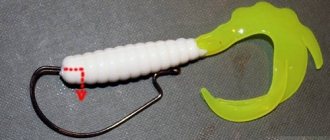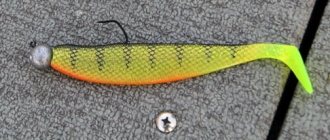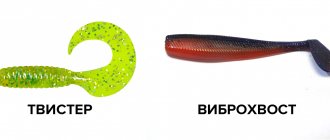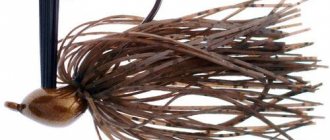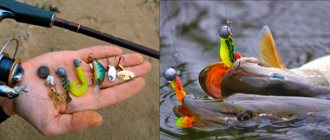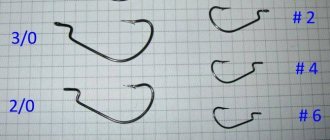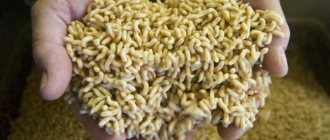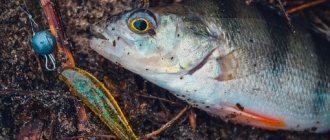Even today, the vibrotail is one of the most competitive baits, allowing you to successfully catch all types of freshwater predatory fish. But as in any important matter, the result of which depends on the implementation of many successive effective operations that collectively bring overall success, and fishing is just such a variant, fishing with a vibrating tail has a number of nuances.
It is about one of these nuances, and in particular how to install a vibrating tail, that we will talk today and try to analyze the main points of its competent execution.
How to properly attach a vibrotail
Silicone jig baits are varied in their shapes and types, and also differ in size and density of the material. All these factors should be taken into account during installation. It’s simply unreasonable to put a silicone bait on a hook, throw it into the water and expect a successful bite. First of all, the fisherman must understand that a vibrating tail can be equipped with different types of hooks: single, offset, double, tee, and this depends on the fishing conditions, the intensity of bites and the type of fish that the fisherman is counting on. The easiest way to attach a vibrating tail is to a jig head.
Important! Select the place where the wide back of the vibrotail transitions into its narrow tail. This transition point should be the point where the hook tip exits the body of the bait.
We pierce the vibrating tail with a sting at the location of the mouth of the artificial fish and string its body until the sting of the hook reaches the point of exit to the surface that we have chosen. We bring the point in the back of the artificial fish to half the roundness of the hook of the jig head. This completes the installation.
Important! The hook of the jig head must correspond to the size of the vibrating tail from the mouth of the fish to the point where the tip of the hook is brought to the surface of the back of the nozzle.
Difference in Shape
Jig heads can come in a wide variety of shapes. Their names largely explain their appearance:
- ball;
- rugby (ball);
- "digger";
- fish head;
- bullet;
- spoon;
- ski;
- boot;
- banana;
- Vanka-Vstanka;
- horseshoe.
The head weight can be made without a hook. Then a hinge joint is used to connect the sinker and the hook. Individual heads are manufactured in three types:
- eared sinker (“Cheburashka”);
- lentils.
Despite the variety of jig head shapes, the main parameter when selecting is weight. It is the weight of the sinker and bait that determines the horizon of the rig’s passage.
For fishing in standing and shallow reservoirs, heads weighing 1-15 g are used. For river fishing, as well as in reservoirs with great depths (more than 5 m), jig heads weighing up to 40 g are required.
For bass, rubber lures called swallows work well with triangle jig heads. Thanks to this shape, the swallow jumps to the sides when descending, which effectively attracts perch.
Tips for fisherman: How to choose an offset hook for silicone bait - Detailed review
Triangular jig heads are also suitable for walleye. If you're fishing in shallow areas, a good solution is to use lightweight jig heads that won't sink to the bottom too quickly. When searching for pike perch at great depths, where they are usually found, it is worth using heavier options, weighing 15-20 grams.
When choosing a jig head for pike, you should carefully look at the shape of the hook. Hooks that have the shape of a flip-over arc are especially effective. Thanks to this, even in the event of severe jamming, the element reliably penetrates the hard tissues of the fish, does not bend and holds well. What is important is that pike also react to colors.
4. Apply a little of the resulting composition to the shank of the hook, where the head is supposed to be secured - in the area of the eye of the hook. We move the head here and press it tightly to the eye of the hook. The viscous composition fills the hole in the weight. If excess glue is squeezed out, remove it. If the hook is thin and the diameter of the hole in the head is very large, you can additionally fill the hole with glue.
06.04.2016 03:51 06.04.2016 03:51:01
How to catch passive trout? On the "rubber". What type of tire can you use to catch trout? For worms and nymphs. What hooks and jig heads should I mount my worm/nymph on? Do it yourself.
Yes, there have already been publications on this topic, but the methods described are, in my opinion, far from ideal. I suggest anglers still evaluate different methods and choose the most convenient for each. Perhaps someone will be interested in the technology I use. Naturally, such micro-jig heads can be used not only for catching trout, but also for catching other fish, for example, perch. So, initially you need to decide on the hooks and the required set of head weights.
Diameter 3mm - weight 0.17g Diameter 3.3mm - weight 0.3g Diameter 4mm - weight 0.44g Diameter 4.5mm - weight 0.8g Diameter 5.5mm - weight 1.3g.
How to connect the hook and head. How to do this quickly and reliably? You will need Poxipol cold welding, a sheet of paper and a toothpick. All! Having tried several methods and types of glue, I came to this particular option. It's fast, reliable, economical, safe. Perhaps some people use two-part epoxy or another brand of glue, but I'm speaking from my experience. I think it’s important to outline the sequence of actions to help avoid some mistakes.
1. Select the desired hook and head weight. I came to the conclusion that I make five heads in one short production cycle - this quantity allows for optimal use of the Poxipol hardening time.
2. Squeeze a small amount of glue from each tube onto a sheet of paper - less than a pea.
3. Mix both components with a toothpick. The result is a viscous composition that will gradually harden within 3-5 minutes.
4. Apply a little of the resulting composition to the shank of the hook, where the head is supposed to be secured - in the area of the eye of the hook. We move the head here and press it tightly to the eye of the hook. The viscous composition fills the hole in the weight. If excess glue is squeezed out, remove it. If the hook is thin and the diameter of the hole in the head is very large, you can additionally fill the hole with glue.
5. It is convenient to dry the heads in a suspended state - in this position the head cannot move while the glue hardens.
6. After 5-10 minutes the glue will finally harden - your jig head is ready!
You can slightly improve the resulting jig heads - several tight loops of ordinary thread are knitted onto the shank of the hook and fixed with instant glue - the resulting “boss” will help hold the silicone bait on the hook. If necessary (for example, the hook has become dull), the head can be removed and used on another hook. To do this, you need to heat the eye of the hook with a lighter until the glue melts - remove the head and we can use it further.
I will also give a few examples of what equipped baits look like.
So, a jig head is a rig for soft baits that combines a single hook and sinker. The connection between the weight and the hook is rigid.
Date: February 19, 2021 | 908
When fishing with soft baits, silicone, it is important not only to choose the type and size of the bait, but also to choose the right way to mount it. One of the most common types of silicone bait equipment is the jig head . This is the simplest and most popular installation, with its advantages and disadvantages. And now I want to share my opinion about equipping silicone baits on a jig head, discuss the advantages, disadvantages and features of this type of installation.
So, a jig head is a rig for soft baits that combines a single hook and sinker. The connection between the weight and the hook is rigid.
The main advantages of a jig head compared to other rigs:
— Good execution of sweeps.
— Slightly less grip on snags (compared to hinged mounting with an open hook).
— The best controllability of the bait, because the bait, hook and sinker are obtained in a monolithic structure, without wobbling. All impulses that the angler makes are directly and unambiguously transmitted to the entire bait.
Main disadvantages of a jig head :
— Not the highest casting range due to the increased windage of the rigid installation.
Tips for a fisherman: How to attach a silicone bait to a double - All the nuances
— Limiting the movements of the bait, deteriorating the play of some silicone models.
— The G-head does not allow the buoyancy of some silicone baits to be used very well as an additional attractive factor.
Now let's look at how different types of silicone baits behave on jig heads.
Vibrating tail on a jig head . Vibrating tails and rippers are perhaps one of the most popular baits among our spinning jig players. If we talk about attaching vibrating tails to a jig head, this is the most successful solution and combination! Moreover, there is no other type of soft bait that works so well with vibrating tails.
The essence of the vibrating tail game is, first of all, the vibration of the tail-penny. When the body of a vibrating tail is mounted on a rigid mount, on a jig head, then the tail plays optimally, oscillating relative to the body.
Of course, it’s very good when not only the tail of the bait works, but there is also some interesting play of the whole body of the silicone.
So, if you equip a vibrotail with the lightest possible jig head, then the vibrotail also receives vibrations with some rotation relative to the longitudinal axis.
In addition, you can enhance the effect of such vibrations by using different shapes of jig heads. These can be jigs such as “boot”, “spoon”, etc.
Twister on a jig head . Twisters are also a popular class of silicone baits in the fall. Like vibrating tails, twisters are active silicone that plays when applied evenly.
Slugs and other passive baits on a jig head . Passive silicone baits do not work so well with a jig head. Slugs, silicone worms, crayfish, cuttlefish, etc. - these are baits that need to be set in motion by a spinning rod.
So, if we need to loosen up a passive bait as much as possible, then we forget about jig heads and use a hinge or lead rigs. If we want to achieve maximum controllability of the bait, for example, for clear tracking with short jumps, steps along the bottom, then we can use a jig head for such passive baits.
This is how I see the place of jig heads in equipping silicone baits, edibles of various shapes and types.
You can slightly improve the resulting jig heads - several tight loops of ordinary thread are knitted onto the shank of the hook and fixed with instant glue - the resulting “boss” will help hold the silicone bait on the hook. If necessary (for example, the hook has become dull), the head can be removed and used on another hook. To do this, you need to heat the eye of the hook with a lighter until the glue melts - remove the head and we can use it further.
06.04.2016 03:51 06.04.2016 03:51:01
How to catch passive trout? On the "rubber". What type of tire can you use to catch trout? For worms and nymphs. What hooks and jig heads should I mount my worm/nymph on? Do it yourself.
Yes, there have already been publications on this topic, but the methods described are, in my opinion, far from ideal. I suggest anglers still evaluate different methods and choose the most convenient for each. Perhaps someone will be interested in the technology I use. Naturally, such micro-jig heads can be used not only for catching trout, but also for catching other fish, for example, perch. So, initially you need to decide on the hooks and the required set of head weights.
Diameter 3mm - weight 0.17g Diameter 3.3mm - weight 0.3g Diameter 4mm - weight 0.44g Diameter 4.5mm - weight 0.8g Diameter 5.5mm - weight 1.3g.
How to connect the hook and head. How to do this quickly and reliably? You will need Poxipol cold welding, a sheet of paper and a toothpick. All! Having tried several methods and types of glue, I came to this particular option. It's fast, reliable, economical, safe. Perhaps some people use two-part epoxy or another brand of glue, but I'm speaking from my experience. I think it’s important to outline the sequence of actions to help avoid some mistakes.
1. Select the desired hook and head weight. I came to the conclusion that I make five heads in one short production cycle - this quantity allows for optimal use of the Poxipol hardening time.
2. Squeeze a small amount of glue from each tube onto a sheet of paper - less than a pea.
3. Mix both components with a toothpick. The result is a viscous composition that will gradually harden within 3-5 minutes.
4. Apply a little of the resulting composition to the shank of the hook, where the head is supposed to be secured - in the area of the eye of the hook. We move the head here and press it tightly to the eye of the hook. The viscous composition fills the hole in the weight. If excess glue is squeezed out, remove it. If the hook is thin and the diameter of the hole in the head is very large, you can additionally fill the hole with glue.
5. It is convenient to dry the heads in a suspended state - in this position the head cannot move while the glue hardens.
6. After 5-10 minutes the glue will finally harden - your jig head is ready!
You can slightly improve the resulting jig heads - several tight loops of ordinary thread are knitted onto the shank of the hook and fixed with instant glue - the resulting “boss” will help hold the silicone bait on the hook. If necessary (for example, the hook has become dull), the head can be removed and used on another hook. To do this, you need to heat the eye of the hook with a lighter until the glue melts - remove the head and we can use it further.
Tips for fisherman: How to attach a silicone bait to a jig head - Let's take it step by step
I will also give a few examples of what equipped baits look like.
If fishing is carried out from a boat, then a long spinning rod is absolutely not needed. On the contrary, with a shorter one, catching a predator from a boat is much more convenient. Therefore, a spinning rod with a length of 1.9 to 2.4 meters is suitable for such conditions.
Correct placement of silicone on the offset press
It is not much more difficult to correctly attach the vibrating tail to the offset press. This installation is successfully used for catching predators in snags in water bodies. Taking the offset tool in your hands, we thread it into the fish’s mouth and remove the hook tip under the lower part of the head of the vibrotail. Then we stretch the hook along the body of the fish and pierce the belly of the silicone right through to its back from the inside. We bring the tip of the offset machine strictly parallel to the back of the nozzle, trying to press the tip as tightly as possible to the body of the vibrotail. Installation is complete. A silicone fish can be attached to a single hook without much difficulty, which cannot be said about mounting it on a double or tee.
Equipping a vibrating tail with a double
Rigging a vibrating tail on a double requires selecting a hook with a long shank. Attaching a vibrating tail to a jig with this type of double greatly simplifies the task.
As when mounting on a single type of hook, we determine the point for piercing the bait, only now this will not be the point where the tip exits, but the place where the double ring is inserted into the body of the bait, and the point will not be on the back, but on the side. Slightly spreading the hooks of the double, we pierce the fish through the side with one hook and string the silicone along the entire fore-end. As a result, it will turn out that the vibrating tail will hang with its back between the two hooks of the double. Then, pressing the ring into the body of the bait towards its mouth, we thread the silicone through until the fastening ring comes out of the fish’s body. The installation is almost complete, all that remains is to straighten the nozzle to the length of the entire shank of the hook so that it receives its original geometric dimensions and is not subject to deformation.
Important! A deformed bait has a noticeably more negative effect on the quality of its play when fishing.
In most cases, deformations of the silicone bait arise from an incorrectly determined puncture site and from an incorrectly selected length of the shank of the vibrotail hook. In case of sluggish bite, uncertain bites and frequent gatherings, it is reasonable to equip the bait with a jig using a tee in the installation. This installation option allows you to increase the chances of catching a cautious and fastidious predator.
Tee equipment
To equip vibrotails with triple hooks, you will need additional unpretentious equipment in the form of a metal or plastic tube with a diameter of no more than five millimeters. The length is enough to be 2 cm. The tube should be one and a half times the thickness of the silicone bait being mounted. This device is needed to make a through hole in the side of the vibrating tail body for mounting a tee.
Important! The hole should be optimal in diameter based on the size of the tee. A small hole will not allow symmetrical installation of the tee hooks, and a large hole will increase the play of the tee during wiring and will deteriorate the quality of the nozzle’s play.
As in the first installation diagrams, markings are made to determine the point of the required hole. The length of the forend of the tee, excluding the loop for fastening, will be our main guideline. We pierce the vibrating tail with a previously prepared tube, since silicone is a pliable material for these manipulations. Next, in the hole made towards the mouth of the fish inside the body of the bait, we thread the triple hook through the front with a fastening ring. Stretching the hole previously made with a tube, we transfer the first tip of the tee to the opposite side of the artificial fish.
We pierce the back with the second sting through the same hole, bringing the tip parallel to the back of the silicone, and leave the third hook without any manipulation. In principle, the installation of the vibrating tail on the tee can be considered complete. The disadvantages of this installation are its rather low cross-country ability in fishing areas with vegetation. The best option for using silicone baits on tees is in clean areas of the reservoir.
Spinning for jig
The choice of jig rod is a very important factor influencing fishing performance. The characteristics of the rod must match the characteristics of the bait, otherwise it will not be possible to plausibly move the bait and hook the fish in time. The spinner must feel the bait and control it. It is very important to decide on the fishing conditions: either from the shore or from a boat. Only after determining the main factors that you will encounter while fishing should you start choosing a spinning rod.
If fishing is carried out from a boat, then a long spinning rod is absolutely not needed. On the contrary, with a shorter one, catching a predator from a boat is much more convenient. Therefore, a spinning rod with a length of 1.9 to 2.4 meters is suitable for such conditions.
For fishing from the shore, the following philosophy is suitable: the longer the spinning rod, the better, since you can’t do without long casts. But again, the larger the spinning rod, the heavier it is, and this is an additional load on the hands. Plus, there may be vegetation on the shore of the reservoir, which complicates the use of long rods. In this regard, you can focus on the following dimensions: 2.7-3.0 meters. As practice shows, such a form is absolutely sufficient for fishing from the shore.
All fishing rods are divided into certain categories, including by the nature of the rod's structure. For jig fishing, a fast or super-fast action may be most effective. This is necessary for fast and reliable hooking. In addition, fast action rods respond faster to bites. This is especially important when fishing for pike perch. It has a very powerful jaw, which needs to be broken through by hooking, and besides, the pike perch takes the bait very carefully.
The last group is rods with a weight of more than 30 grams, which are used for fishing at great depths and over long distances, where heavy jig heads are used. This subspecies is relevant if you have to fish on a river with a fast current.
The material of manufacture also plays an important role. If a fishing rod is made of modern materials, then it is not only durable, but also lightweight. The only drawback of such forms is their high cost, which is inaccessible to a wide range of spinning players.
This is an option for equipping the bait with a jig head.
Using the Akara Eatable R3 as an example, we will show how a silicone bait is equipped with a jig head with a hard-soldered hook.
Tips for fisherman: How to put silicone on a jig head - What to choose for fishing
Photo 1. Reaper Akara Eatable R
Initially, the jig head is applied to the bait itself (Photo 2. 1), we look where the hook should come out. You can remember this place, or simply mark it by slightly tearing the back (2). Measured. And like a worm, having pierced the bait from the head (3), we thread the hook (4, 5) and remove the sting of the jig head in the place where we have already marked (6).
Photo 2. How to attach a silicone bait to a jig head
Thus, the bait is fixed on the jig head. Here it has a lead locking ledge of this type.
Photo 3. Fixing the bait on the jig head.
The bait is securely held on the jig head. The tail of the bait remains free, it is not fixed with a hook. Accordingly, the game of the bait remains very active.
Photo 4. Installation with jig head is ready.
This is an option for equipping the bait with a jig head.
The jig head can also be equipped with various rippers, vibrating tails, twisters, etc. In principle, this is the main and most reliable way to equip a silicone bait. But, if there are a lot of snags in the fishing area - snags, stones, some kind of grass. we need to protect the bait from these hooks, and accordingly resort to equipping the bait with an offset hook.
This is especially true for pike - not only does the spotted pike have a hard mouth studded with teeth, it has two long cavities in the upper jaw, covered only with thin skin, into which a single hook often falls.
The importance of equipping a vibrotail when fishing
The ability to correctly, competently and effectively equip vibrotails with various types of hooks allows you to use broader strategies when catching a predator. After all, these types of equipment, excluding only the attachment of a vibrotail on solid jig heads, make it possible to use silicone baits in combination with replaceable articulated weights, so-called Cheburashkas among fishermen, as well as when fishing with a bombard under various fishing conditions. Equipping the vibrating tail with an offset hook, double and tee can be safely called universal. After all, by manipulating the load of the Cheburashka and the float of the bombard by type and weight, the bait can be used at different depths and at the same time perform different types of postings.
Well, by changing the types of hooks, you can successfully catch them in overgrown and snagged areas of the reservoir and when the predator is passive. Therefore, the arsenal of fishing lures for those who like to catch predators representing freshwater bodies of water should include all the types of installation discussed above. After all, equipment prepared at home will save valuable time on fishing and increase the fisherman’s chances of a successful fishing outcome, even despite the prevailing conditions of the fishing session.
Types of jig heads
Weight
Standard weights of jig heads are from 1 to 50 g. Based on weight, there are five classes of jig heads: • jig heads for nanojig - weighing up to 3 g; • microjig heads - 3-7 g; • light jig heads - 7-21 g; • medium - 21-42 g; • heavy jig heads - weighing more than 42 g
Material
Based on the material, jig heads are: • lead; • tungsten. Lead jig heads are the most popular. This material has sufficient mass, while it is affordable and easy to process (which makes it easy to make lead jig heads at home). The main advantage of tungsten is its high specific gravity (this metal is almost twice as heavy as lead). And although for the production of jig heads it is not pure tungsten that is used, but its alloys, which weigh less, such heads are still much more compact than lead weight heads of similar weight. This allows you to cast as far as possible; in addition, the compact jig head sinks faster, which is important when fishing at great depths and in strong currents.
Form
The shape of the jig load directly affects the performance of the bait and the comfort of fishing in certain conditions. On sale you can find jig heads of such shapes as: • ball; • boot; • spoon; • banana; • rugby; • ski; • fish head. Ball jig heads are the most popular among spinning anglers. This is the most universal form; heads of this type can be successfully used on any body of water and in almost any conditions. At great depths and in strong currents, jig heads of streamlined shapes, which experience less water resistance when immersed, are most suitable. It is also necessary to mention the planning jig head. The weight of such a head is welded from three planes, each of which is usually made in the shape of a “half-heart”. This jig head has a number of undeniable advantages compared to other types of cargo. When retrieving, it instantly lifts off the bottom at the first turn of the reel handle and floats, avoiding obstacles, which is very convenient when fishing on a cluttered bottom.
Unhooked
In jig fishing, it often becomes necessary to comb through thick snags, grass thickets and other strong places with bait - after all, this is where predatory fish almost always stand. In this case, it is necessary to use hook-on heads. There are two types of non-snagging jig heads: • jig heads with wire tendrils; • jig heads based on offset hooks. In addition, when fishing with an eared sinker on foam rubber, rigs based on double hooks with hooks pressed to the body of the foam rubber fish are used.
Floating jig head
Separately, it is worth mentioning the floating jig head, which is used for fishing with silicone baits in the surface layer of water. In this way, you can very successfully catch pike “over the grass,” as well as hunt for perch and asp during their fight. Ready-made floating jig heads that can be found on sale are made of various lightweight materials; homemade ones are usually made from cork and loaded with lead.
